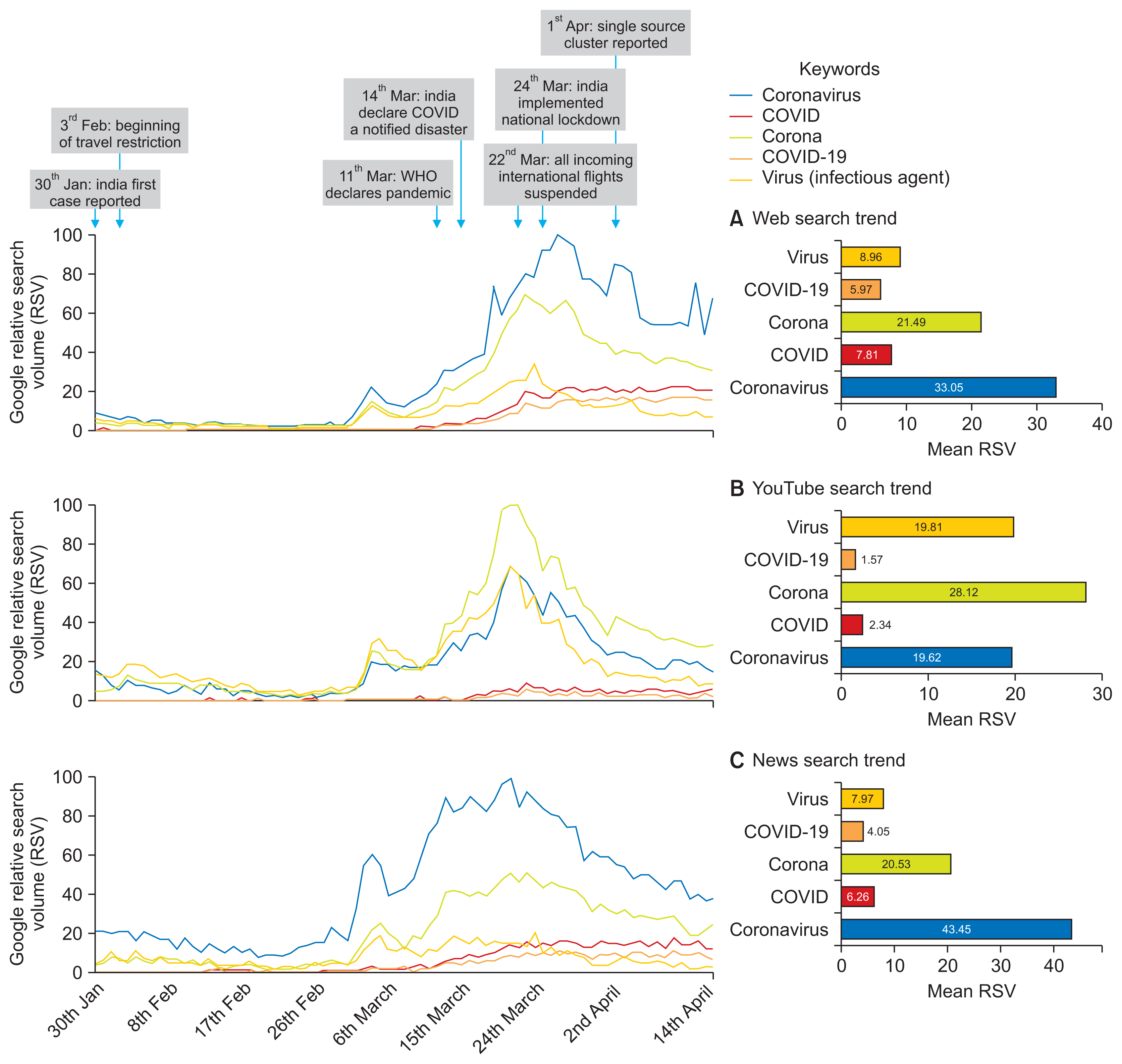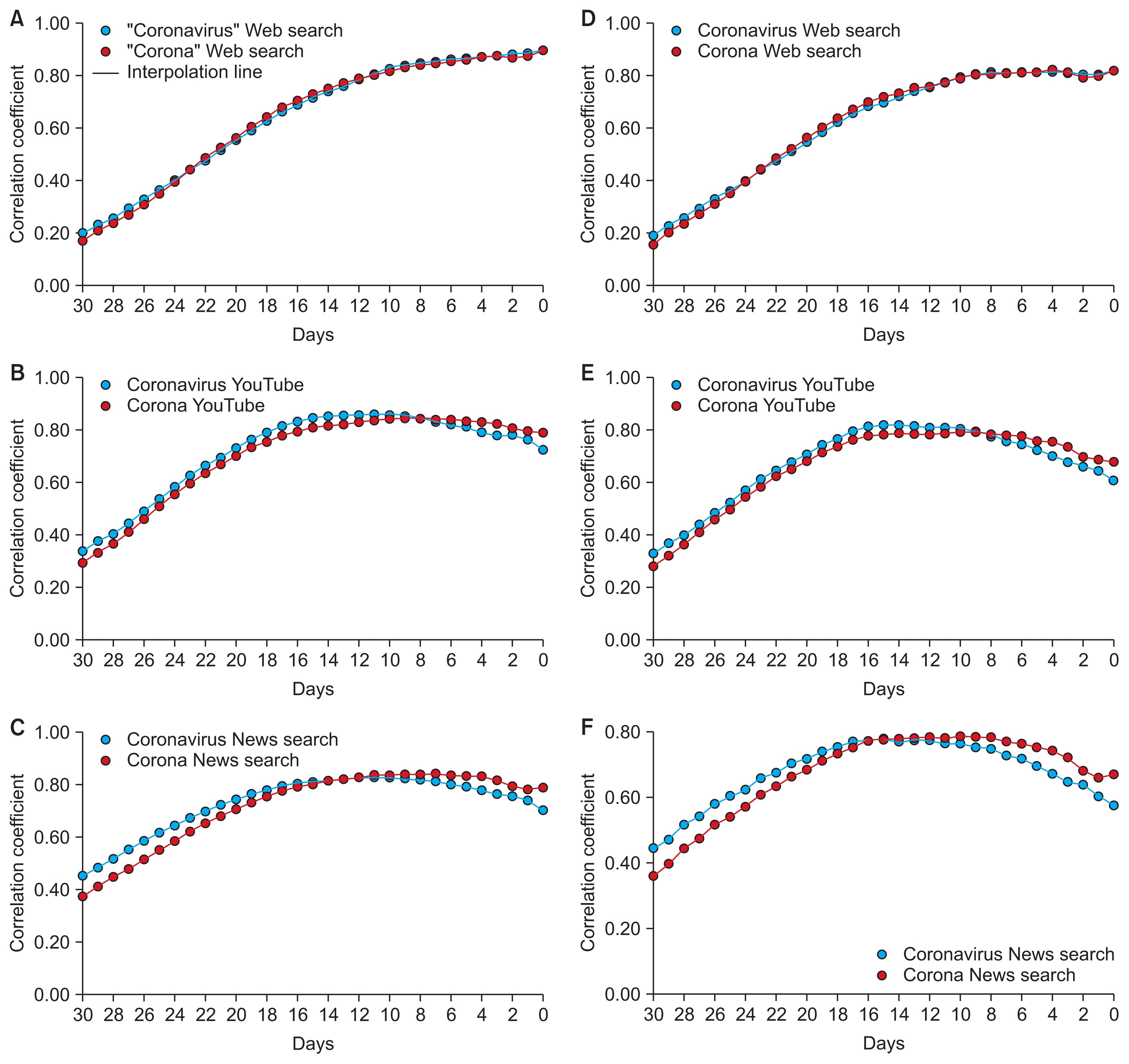Healthc Inform Res.
2020 Jul;26(3):175-184. 10.4258/hir.2020.26.3.175.
Prediction of COVID-19 Outbreaks Using Google Trends in India: A Retrospective Analysis
- Affiliations
-
- 1Department of Community Medicine, Vardhman Mahavir Medical College (VMMC) and Safdarjung Hospital, New Delhi, India
- 2Department of Community Medicine and School of Public Health, Postgraduate Institute of Medical Education and Research, Chandigarh, India
- KMID: 2505258
- DOI: http://doi.org/10.4258/hir.2020.26.3.175
Abstract
Objectives
Considering the rising menace of coronavirus disease 2019 (COVID-19), it is essential to explore the methods and resources that might predict the case numbers expected and identify the locations of outbreaks. Hence, we have done the following study to explore the potential use of Google Trends (GT) in predicting the COVID-19 outbreak in India.
Methods
The Google search terms used for the analysis were “coronavirus”, “COVID”, “COVID 19”, “corona”, and “virus”. GTs for these terms in Google Web, News, and YouTube, and the data on COVID-19 case numbers were obtained. Spearman correlation and lag correlation were used to determine the correlation between COVID-19 cases and the Google search terms.
Results
“Coronavirus” and “corona” were the terms most commonly used by Internet surfers in India. Correlation for the GTs of the search terms “coronavirus” and “corona” was high (r > 0.7) with the daily cumulative and new COVID-19 cases for a lag period ranging from 9 to 21 days. The maximum lag period for predicting COVID-19 cases was found to be with the News search for the term “coronavirus”, with 21 days, i.e., the search volume for “coronavirus” peaked 21 days before the peak number of cases reported by the disease surveillance system.
Conclusions
Our study revealed that GTs may predict outbreaks of COVID-19, 2 to 3 weeks earlier than the routine disease surveillance, in India. Google search data may be considered as a supplementary tool in COVID-19 monitoring and planning in India.
Keyword
Figure
Reference
-
References
1. World Health Organization. Coronavirus disease (COVID-19) situation report 169 [Internet]. Geneva, Switzerland: World Health Organization;2020. [cited at 2020 Jul 17]. Available from: https://www.who.int/docs/default-source/coronaviruse/situation-reports/20200707-covid-19-sitrep-169.pdf?sfvrsn=c6c69c88_2.2. Gandhi PA, Kathirvel S. Epidemiological studies on COVID-19 pandemic in India: too little and too late? Med J Armed Forces India. 2020. May. 12. [Epub]. http://doi.org/10.1016/j.mjafi.2020.05.003.
Article3. Government of India, Ministry of Health & Family Welfare. Integrated Disease Surveillance Programme (IDSP) [Internet]. Delhi, India: Ministry of Health & Family Welfare;c2020. [cited at 2020 Jul 8]. Available from: https://idsp.nic.in/index1.php?lang=1&level=1&sublinkid=5772&lid=3698.4. Seo DW, Jo MW, Sohn CH, Shin SY, Lee J, Yu M, et al. Cumulative query method for influenza surveillance using search engine data. J Med Internet Res. 2014; 16(12):e289.
Article5. Shin SY, Seo DW, An J, Kwak H, Kim SH, Gwack J, et al. High correlation of Middle East respiratory syndrome spread with Google search and Twitter trends in Korea. Sci Rep. 2016; 6:32920.
Article6. Verma M, Kishore K, Kumar M, Sondh AR, Aggarwal G, Kathirvel S. Google Search Trends predicting disease outbreaks: an analysis from India. Healthc Inform Res. 2018; 24(4):300–8.
Article7. Yuan Q, Nsoesie EO, Lv B, Peng G, Chunara R, Brownstein JS. Monitoring influenza epidemics in china with search query from baidu. PLoS One. 2013; 8(5):e64323.
Article8. Mandavia M. India has second highest number of Internet users after China: Report [Internet]. Mumbai, India: The Economic Times;2019. [cited at 2020 Jul 17]. Available from: https://economictimes.indiatimes.com/tech/internet/india-has-second-highest-number-of-internet-users-after-china-report/articleshow/71311705.cms?from=mdr.9. StatCounter. Search engine market share India (June 2019–June 2020) [Internet]. Dublin, Ireland: Stat-Counter;c2020. [cited at 2020 Jul 17]. Available from: https://gs.statcounter.com/search-engine-market-share/all/india.10. Laghate G. YouTube in India has over 265 mn monthly active users 1200+ channels with 1 mn+ subs [Internet]. Mumbai, India: The Economic Times;2019. [cited at 2020 Jul 17]. Available from: https://economictimes.indiatimes.com/industry/media/entertainment/youtube-in-india-has-over-265-mn-monthly-active-users-1200-channels-with-1-mn-subs/articleshow/72456212.cms?from=mdr.11. Seo DW, Shin SY. Methods using social media and search queries to predict infectious disease outbreaks. Healthc Inform Res. 2017; 23(4):343–8.
Article12. Google Trends India [Internet]. Menlo Park (CA): Google Trends;c2020. [cited at 2020 Jul 17]. Available from: https://trends.google.com/trends/?geo=IN.13. Ginsberg J, Mohebbi MH, Patel RS, Brammer L, Smolinski MS, Brilliant L. Detecting influenza epidemics using search engine query data. Nature. 2009; 457(7232):1012–4.
Article14. Li C, Chen LJ, Chen X, Zhang M, Pang CP, Chen H. Retrospective analysis of the possibility of predicting the COVID-19 outbreak from Internet searches and social media data, China, 2020. Euro Surveill. 2020; 25(10):2000199.
Article15. Carneiro HA, Mylonakis E. Google Trends: a web-based tool for real-time surveillance of disease outbreaks. Clin Infect Dis. 2009; 49(10):1557–64.
Article16. World Health Organization. WHO Timeline: COVID-19 [Internet]. Geneva, Switzerland: World Health Organization;c2020. [cited at 2020 Jul 17]. Available from: https://www.who.int/news-room/detail/08-04-2020-who-timeline---covid-19.17. Woo H, Cho Y, Shim E, Lee JK, Lee CG, Kim SH. Estimating influenza outbreaks using both search engine query data and social media data in South Korea. J Med Internet Res. 2016; 18(7):e177.
Article18. Chatterjee K, Chatterjee K, Kumar A, Shankar S. Healthcare impact of COVID-19 epidemic in India: a stochastic mathematical model. Version 2. Med J Armed Forces India. 2020; 76(2):147–55.19. Santangelo OE, Provenzano S, Piazza D, Giordano D, Calamusa G, Firenze A. Digital epidemiology: assessment of measles infection through Google Trends mechanism in Italy. Ann Ig. 2019; 31(4):385–91.20. Provenzano S, Santangelo OE, Giordano D, Alagna E, Piazza D, Genovese D, et al. Predicting disease outbreaks: evaluating measles infection with Wikipedia Trends. Recenti Prog Med. 2019; 110:292–6.21. Wilson N, Mason K, Tobias M, Peacey M, Huang QS, Baker M. Interpreting Google flu trends data for pandemic H1N1 influenza: the New Zealand experience. Euro Surveill. 2009; 14(44):19386.
Article22. Lin YH, Liu CH, Chiu YC. Google searches for the keywords of "wash hands" predict the speed of national spread of COVID-19 outbreak among 21 countries. Brain Behav Immun. 2020; 87:30–2.
Article23. Nuti SV, Wayda B, Ranasinghe I, Wang S, Dreyer RP, Chen SI, et al. The use of Google Trends in health care research: a systematic review. PLoS One. 2014; 9(10):e109583.
Article24. Cervellin G, Comelli I, Lippi G. Is Google Trends a reliable tool for digital epidemiology? Insights from different clinical settings. J Epidemiol Glob Health. 2017; 7(3):185–9.
Article
- Full Text Links
- Actions
-
Cited
- CITED
-
- Close
- Share
- Similar articles
-
- Google Search Trends Predicting Disease Outbreaks: An Analysis from India
- COVID-19 prediction models: a systematic literature review
- Population Mobility, Lockdowns, and COVID-19 Control: An Analysis Based on Google Location Data and Doubling Time from India
- Generation, types and impacts of biomedical waste during COVID-19: Indian context
- Characteristics and related factors of waterborne and foodborne infectious disease outbreaks before and after the onset of the COVID-19 pandemic (2017–2021) in the Republic of Korea: a descriptive study




